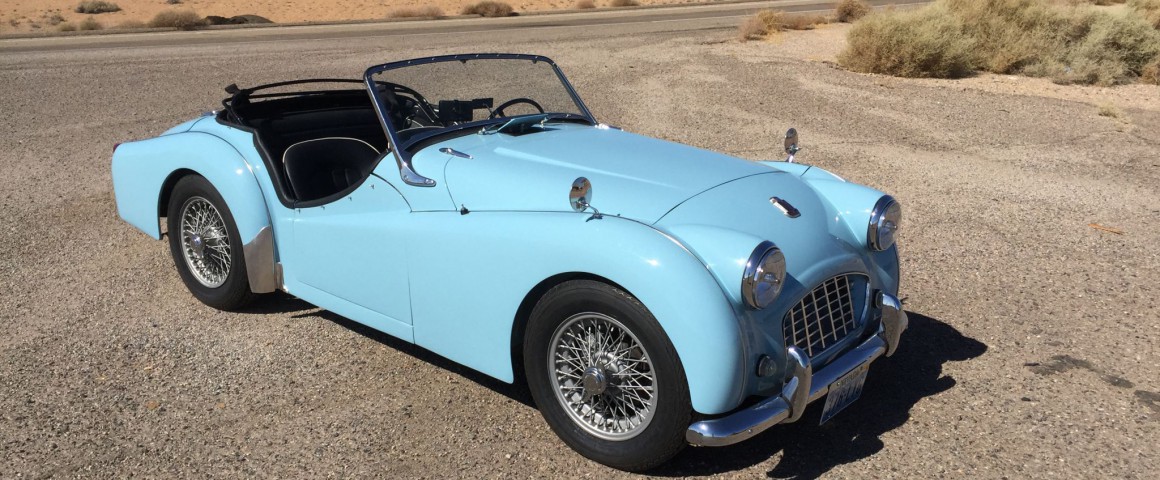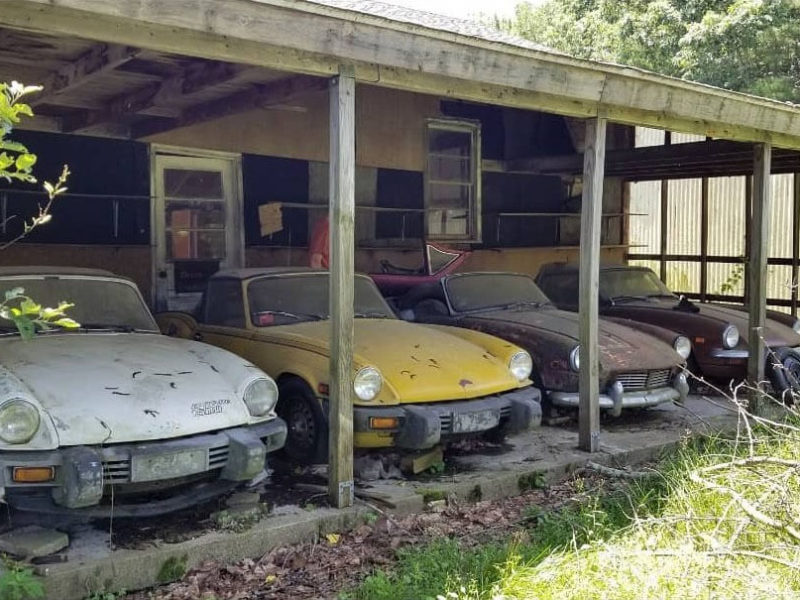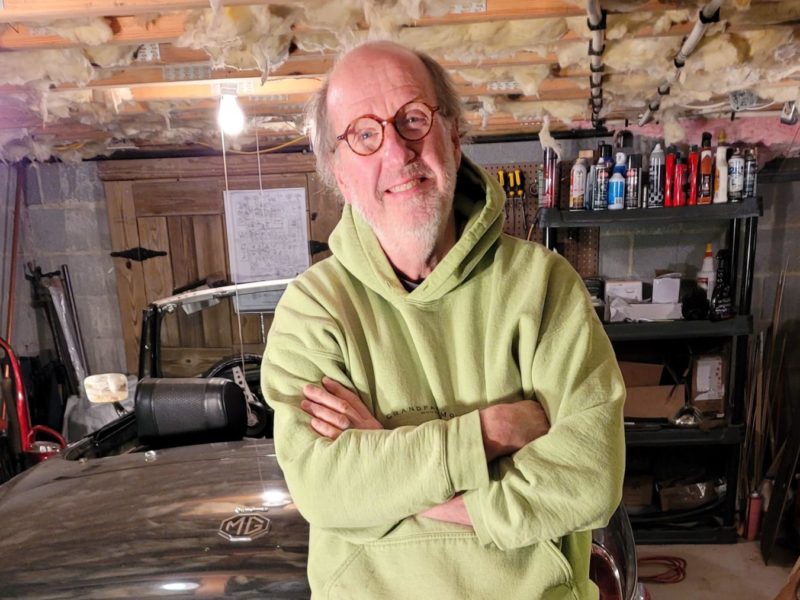A Drive Through the Desert
It started out as many driving adventures have – subject to precious little deliberation but with an ambitious goal to use a British sports car as regular transportation to get from one point to another just like occurred on a regular basis ‘back in the day.’ In this case, the basic plan was to pick up a 1957 Triumph TR3 that we just purchased in Las Vegas and then drive across the desert back to Southern California where the car could replace a pedestrian rental for use during Monterey Car Week.
That was the plan … Things started out roughly according to plan with an arrival at the seller’s shop at 0630 so that I could leave before the arrival of triple digit temperatures around mid-morning. The car had just received a fairly comprehensive cosmetic restoration to a good, but not over the top, standard and we were confident that the trip could be completed without too much trouble. Having covered hundreds of thousands of miles in various Triumphs over the years, I was pleasantly surprised by the power output from the relatively stock engine (which was actually a later unit from a TR4) and that the exhaust emitted a raspy growl that made it almost sound like a racecar.
After a few minutes headed out towards Interstate 15 the first gremlin appeared in the form of an inoperative temperature gauge, but with temperatures only in the low 80s it seemed that the car could make it across the desert without drama if we kept the speed down and kept an eye on the oil pressure gauge for an indication that temperatures under the hood were becoming excessive.
Unlike most Big Healeys that were equipped with overdrive, in comparison few Triumphs were so equipped and since this model was one of them I kept the cruising speed to a tick under 70 mph, which put me at around 3600 rpm or so based on the wildly fluctuating tachometer. Things were going well when the second gremlin appeared – an inoperable fuel gauge. Not wanting to risk the proceedings by running out of gas, I stopped in Barstow and filled up the tank.

What happens when excessive torque is applied to the flywheel bolts and the vehicle driven at speed.
Back on the freeway things went well for the first few miles when the engine shuddered and the gearshift knob popped off the lever and struck me in the head. At the first vibration felt through the seat I had already moved my hand to shut off the ignition and was headed towards the shoulder immediately allowing me to come to a complete stop in only a few hundred yards. Having the dubious experience of having broken down more in British cars than any other human still drawing breath I was out of the driver’s seat with the Dzus T-handle key in hand. Under the hood, things looked normal, but the fact that I felt the vibration adjacent to my right leg and through the seat (not to mention the gearshift knob making like a rat jumping off a sinking ship) led me to believe that the problem was in the gearbox.
After some basic diagnostic steps like attempting to engage the clutch and shift into gear it was clear that the problem was more than could be dealt with on the side of the road so I pulled out the AAA card and called for a tow. This being the era of social media I hopped on Facebook and posted photographs from this tale of woe, along with my guess that the transmission had bitten the dust.
Maybe Modern is Better

Long a fixture in the Triumph community, Herman’s conversions are considered state of the art in modern transmission kits.
Within minutes the comments section to my post was filled with references to the same name – Herman van den Akker. Of course, being a Triumph guy and a fellow SCTOA member, the name was familiar, as was the man. Long regarded as a treasure in the Triumph community, Herman pioneered the conversion kit for every single classic TR model, allowing owners to take advantage of modern reliable mechanicals and the availability of a proper fifth gear for relaxed highway cruising. Over the years, Herman has always been around, always eager to sway stories or help with a problem and it struck me as odd that I had never taken the plunge before to install a Triumph 5-speed conversion, especially given the fact that so much of my driving occurs at high freeway speeds.
As a purist, part of my psyche cringes at the thought of Toyota internals hiding underneath the Triumph transmission tunnel, but as a pragmatic driver that covers thousands of miles a year in very old cars, there is no question that the kit has merit. In fact, over several days of deliberation and surveying the multitudes in social media and in the office it was clear that only sensible choice was to make the switch to a modern transmission and the HVDA Conversion Kit. Not only was the availability of an original gearbox replacement a question, but with a non-synchro first gear and almost 4000 rpms at freeway speeds, there is a certain attraction to having a transmission that is as practical as it is trouble-free.
After a long tow back to Las Vegas (where the seller and I could conduct a post mortem) it appeared that the flywheel bolts had been overtorqued at some time in the past, leading to their catastrophic failure with numerous parts loose in the bell housing. Thankful that the flywheel remained in place long enough for me to shut the engine down, the possibility of losing a limb certainly gave me pause. With a cracked bell housing, damage to the input shaft and other failures, it was clear that a replacement – vintage or modern would have to be sourced for the car to return to the road.
I gave Herman a call, explained my dilemma and soon had a plan in the works to use his kit to install a Lexus 5-speed transmission in the Triumph TR3. One of the most knowledgeable Triumph experts around, Herman asked the pertinent questions for the installation and explained the minor tasks necessary to ensure that the transplant went flawlessly. From the outside, there are no signs that an interloper from the east lies beneath, but every mile in traffic and in high speeds promises to offer a much better experience than was possible when the car first rolled forth from Canley.
Is it a significant expenditure? Of course, as was the decision to make the swap in the first place; but it is likely the last time that the transmission will need attention during my lifetime and that – along with the reliability that should ensue – is worth every bit of the initial expenditure in purchasing the kit. After all, isn’t the goal to make our cars more drivable? Sure it is. See you on the road.
Epilogue
Sadly, Herman passed away in December of 2017. Herman was a longtime customer of Moss Motors, and a good friend of Moss Chairman, Robert Goldman. Moss has continued the production of Herman’s 5-speed conversion kits, and they will retain the HVDA name in Herman’s honor.













'A Triumph 5-Speed Conversion Story' have 5 comments
March 13, 2017 @ 8:55 pm Joe
Hello,
I have been contemplating this 5 speed conversion as well for my 1960 TR3. Can you share you total cost of the swap parts and labor? Thanks!
March 24, 2017 @ 3:05 pm nikasj
I think all in it was something around $4500, plus a weekend to install and fuss around with things.
August 7, 2018 @ 5:09 pm Mike Willits
With Herman’s passing does anyone know the status of the company will there be opportunity in the future to again get this kit?
August 8, 2018 @ 9:22 am stuursmad
Mike,
Herman’s terrific conversion kit will be available through Moss in the near future (as of this writing). We will make a public announcement at that time. Thank you!
August 26, 2019 @ 8:14 am John B Perry
Home-Basing in South West Missouri, I have driven my 1958 TR-3 with it’s HVDA Five Speed Conversion as far northwest as the summit of Atigun Pass (Way north of the Arctic Circle in Alaska), as far northeast as Cartwright, Labrador (as far NorthEast as one can drive in North America), and as far south as southwest Texas…….. just shy of 80,000 trouble free miles in 4 1/2 years. An amazing addition to my Road Warrior!! In addition to the Toyota 5-speed gear box, I also am running Toyota 4-pot Brake Calipers off of a 1980 Toyota 4WD Pick Up Truck (a direct bolt on!)
If it is above 32 degree F., the soft top goes down……..